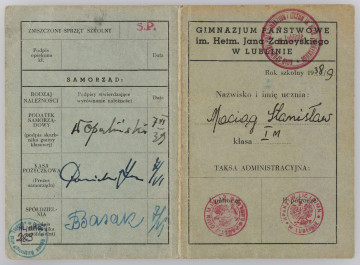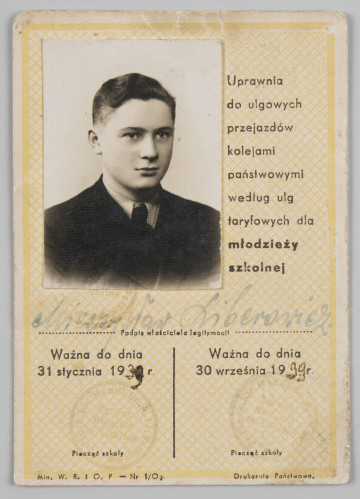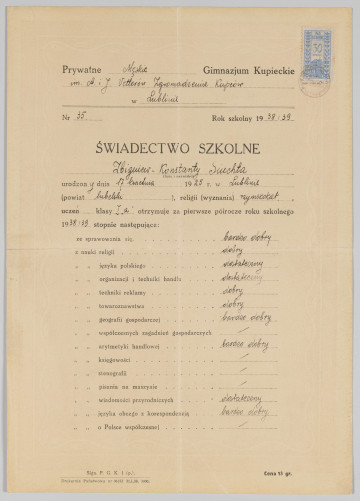
Membership fee payment cards of the Parent Circle at the State Secondary School of Hetman Jan Zamoyski in Lublin
1938 — 1939
National Museum in Lublin
Part of the collection: Education and scouting in Lublin
Scouting played an important role in the school life of the Wacława Arciszowa Private Girls’ Gymnasium. Both the founder of the facility and the teaching staff emphasised that the involvement of students in the activities of youth organisations was very important in the upbringing process. It was argued that it influenced the socialisation and independence of young people and taught them to bear the consequences of their actions.
The first scout patrol at the Gymnasium was established in 1913, a year after the school was launched. The banner, which is in the collection of the ‘Pod Zegarem’ Martyrdom Museum, was embroidered by female scouts in 1939. As of the outbreak of World War II until 1995, it was kept by Zofia Gryga-Putz, who, through Sławomir Litwiński, donated it to the museum collections.
During the September campaign, Antoni Krzyżanowski was the director of the Gymnasium. He was arrested by the Germans on November 9th, 1939 as part of the Sonderaktion Lublin action against the Polish intelligentsia. He was imprisoned at the Lublin Castle. On December 23rd, around 5.00 p.m., along with nine other representatives of the Lublin elite, he was taken to the old Jewish cemetery in Kalinowszczyzna and shot without a trial.
Wanda Półtawska (nee Wojtasik) was one of the students and scouts of the Gymnasium. During the September campaign, she became involved in activities supporting the war efforts at the rear of the warfront. After the fall of the Polish state, she joined the resistance movement. She was arrested on February 17th, 1941 and placed in the ‘Pod Zegarem’ detention centre, then transferred to the Lublin Castle. With a death sentence, she was transported to the German concentration camp for women, Ravensbrück. In the labour camp, she was one of 74 ‘rabbits’ –victims of pseudo-medical procedures carried out by German doctors on female prisoners. She was one of the prisoners responsible for sending secret letters, written with urine, to Poland informing about the situation in the camp. She returned to Poland after the fall of Germany in 1945.
Despite imprisonment, Wanda Wojtasik continued her education at secret classes organised by Polish women in the camp. The level of classes can be evidenced by the fact that she was passed her matriculation examination after the war. As a result she was able to start her medical studies in Krakow. In 1964, she defended her PhD in psychology.
Author / creator
Dimensions
cały obiekt: height: 92 cm, width: 120 cm
Object type
identification mark
Technique
embroidery
Material
silk (natural fabric), thread
Creation time / dating
Creation / finding place
Owner
The National Museum in Lublin
Identification number
Location / status

1938 — 1939
National Museum in Lublin

1939
National Museum in Lublin

1938
National Museum in Lublin
DISCOVER this TOPIC
National Museum in Szczecin
DISCOVER this PATH
Educational path